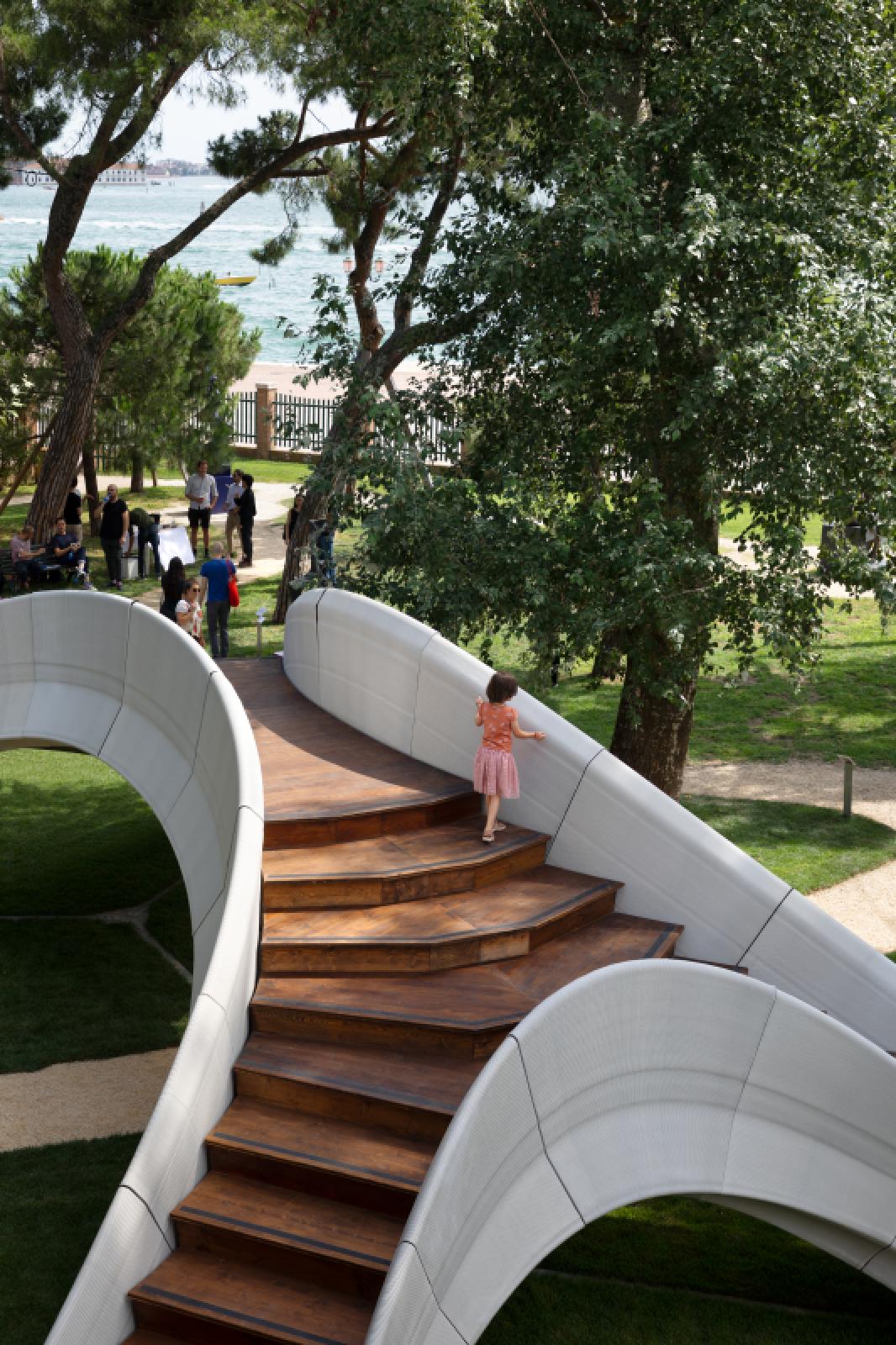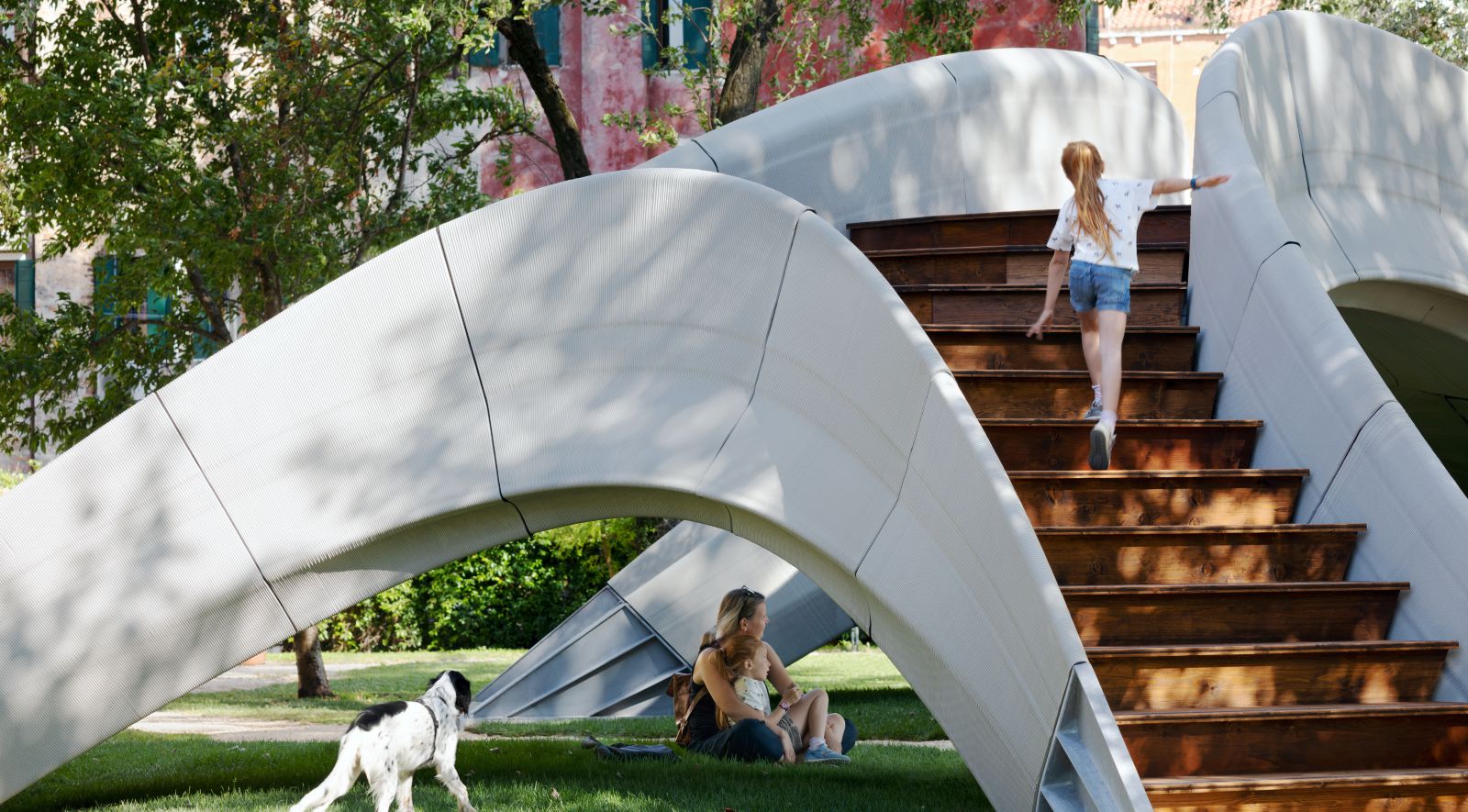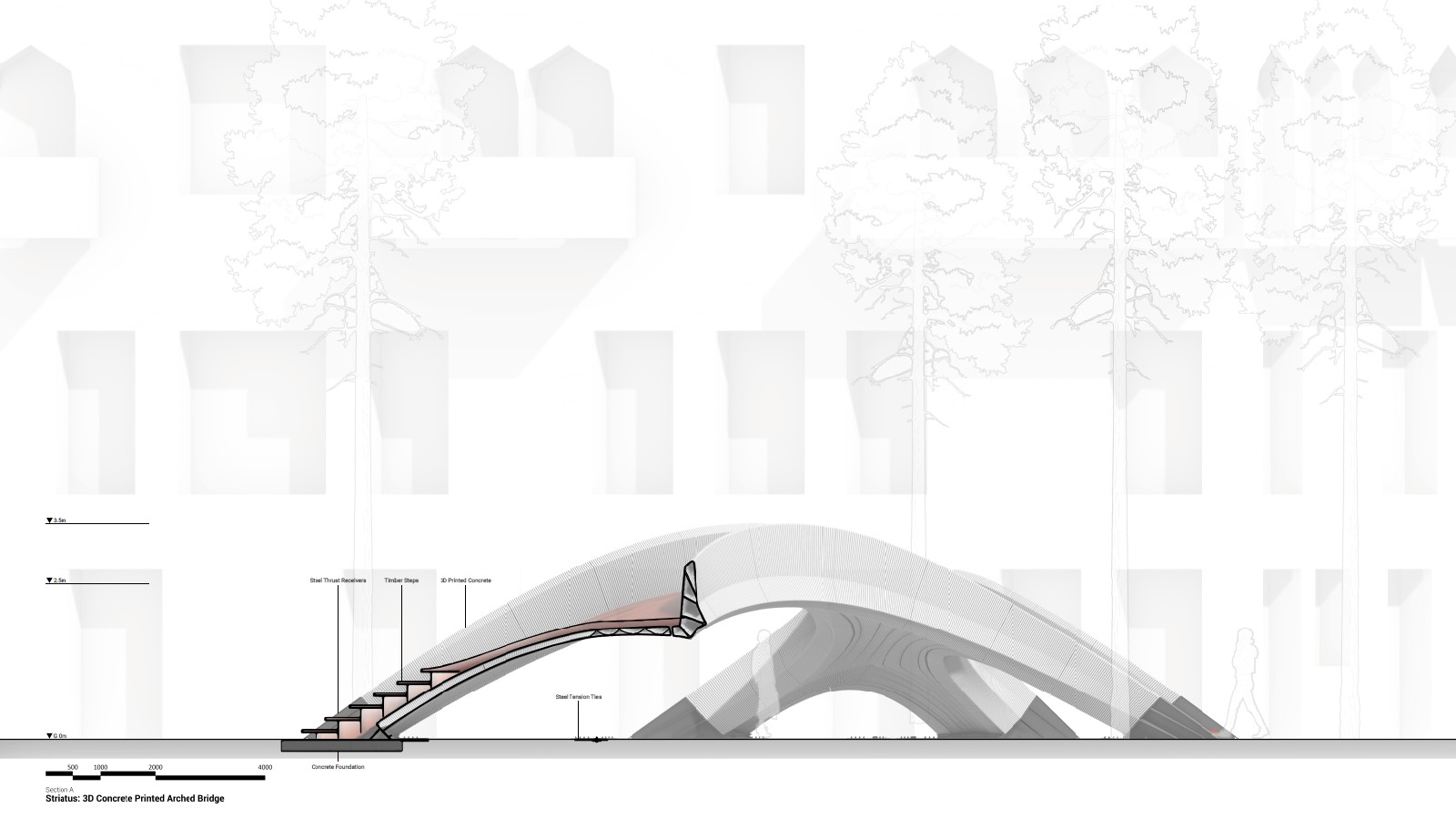Striatus is an arched masonry footbridge composed of 3D-printed concrete blocks assembled without mortar or reinforcement. The 16 x 12 metre footbridge is the first of its kind, combining traditional techniques of master builders with advanced computational design, engineering and robotic manufacturing technologies. Exhibited at the Giardini della Marinaressa during the Venice Architecture Biennale until November 2021.
Striatus has been developed by the Block Research Group (BRG) at ETH Zurich and Zaha Hadid Architects Computation and Design Group (ZHACODE), in collaboration with incremental3D (in3D) and made possible by Holcim. Proposing a new language for concrete that is structurally informed, fabrication aware, ecologically responsible and precisely placed to build more with less, Striatus optimises the properties of masonry structures, 3D concrete printing (3DCP) and contemporary design; presenting an alternative to traditional concrete construction.
Strength through geometry
Striatus is an unreinforced concrete structure that achieves strength through geometry. Concrete can be considered an artificial stone that performs best in compression. In arched and vaulted structures, material can be placed precisely so that forces can travel to the supports in pure compression. Strength is created through geometry, rather than an inefficient accumulation of materials as in conventional concrete beams and flat floor slabs. This presents opportunities to significantly reduce the amount of material needed to span space as well as the possibility to build with lower-strength, less-polluting alternatives.
Striatus’ bifurcating deck geometry responds to its site conditions. The funicular shape of its structural arches has been defined by limit analysis techniques and equilibrium methods, such as thrust network analysis, originally developed for the structural assessment of historic masonry vaults; its crescent profile encompasses the thrust lines that trace compressive forces through the structure for all loading cases. Steel tension ties absorb the horizontal thrust of the arches.
Neoprene pads placed in between the dry-assembled blocks avoid stress concentrations and control the friction properties of the interfaces. In plan, the boundaries of the structure form deep arches that transfer horizontal loads (for example, from visitors leaning against the balustrades) to the supports in pure compression. Advanced discrete element modelling (DEM) was used to refine and optimise the blocks’ stereotomy and to check stability of the entire assembly under extreme loading cases or differential settlements of the supports.
The bridge’s 53 3DCP voussoirs have been produced using non-parallel print layers that are orthogonal to the dominant flow of forces. This avoids delamination between the print layers as they are held together in compression. The additive manufacturing process ensures the structural depth of the components can be achieved without producing blocks with a solid section, hence reducing the amount of material needed compared to subtractive fabrication methods or casting.
Striatus follows masonry structural logic on two levels. As a whole, the bridge behaves as a series of leaning unreinforced voussoir arches, with discretisations orthogonal to the dominant flow of compressive forces, following the same structural principles as arched Roman bridges in stone. Locally, on the level of the voussoir, the 3DCP layers behave as traditional brick masonry evident in the inclined rows of bricks within Nubian or Mexican vaulting.
Circular by design
Circular by design, Striatus places material only where needed, significantly reducing its environmental footprint. Built without reinforcement and using dry assembly without binders, Striatus can be installed, dismantled, reassembled and repurposed repeatedly; demonstrating how the three R’s of sustainability (Reduce, Reuse, Recycle) can be applied to concrete structures.
Robotic 3D concrete printing
Unlike typical extrusion 3D printing in simple horizontal layers, Striatus uses a two-component (2K) concrete ink with corresponding printing head and pumping arrangement to precisely print non-uniform and non-parallel layers via a 6-axis, multi-DOF robotic arm. This new generation of 3D concrete printing in combination with the arched masonry design allows the resulting components to be used structurally without any reinforcement or post-tensioning.
To prevent misalignment between the direction of structural forces and the orientation of material layers that arises from typical shape-agnostic slicing of explicitly modelled geometry, a custom-developed design pipeline was formulated for Striatus to ensure that its printed layers are wholly aligned with the direction of compression forces throughout the entire bridge and also locally through each 3D-printed block. To address issues and challenges that could prevent in-between stability during printing, the coherence and feasibility of the gradually evolving print paths have been modelled using a Functional Representation (FRep) process.

Photo © naaro
This process encodes and continuously checks rules of minimum overlap, maximum cantilever between print layers and print length, print speed and the volume of wet concrete extruded. A nuanced aspect of robotic 3DCP masonry is the re-introduction of intelligence and highly skilled labour into the manufacturing and construction industry. The digitisation of fabrication and digital augmentation of skilled assembly and construction techniques makes historically-accrued knowledge accessible to younger generations and enables its systematic upgrade towards industrialised construction through the use of computational and robotic technologies.
Computational design-to-construction integration
Integrating design, engineering, fabrication and construction, Striatus redefines conventional interdisciplinary relations. The precise manufacturing of the blocks was enabled by well-defined data exchange between the various domain-specific software toolchains involved in the process. This co-development approach was facilitated through the use of COMPAS, an open-source computational framework for collaboration and research in the AEC industry, which enabled the fluent interaction among the key players of the project, working together in five different countries, under a very tight schedule and budget, at a time in which travelling was not possible.
Striatus offers a blueprint for building more with less
Compared to typical reinforced-concrete flat floor slabs, this new floor system uses only 30% of the volume of concrete and just 10% of the amount of steel. The very low stresses within the funicular structure also enable the use of low-embodied-carbon concrete that incorporates high percentages of recycled construction waste. Prefabricated and dry-assembled, and therefore fully demountable and reusable, this floor system is easily and cleanly recyclable at end-of-life.
With an estimated 300 billion square metres of floor area to be constructed worldwide over the next 30 years, and floors comprising more than 40% of the weight of most high-rise buildings (10+ storeys), introducing the principles demonstrated by Striatus would truly disrupt the construction industry — transforming how we design and construct our built environment to address the defining challenges of our era. Source and photos Courtesy of Zaha Hadid Architects.











